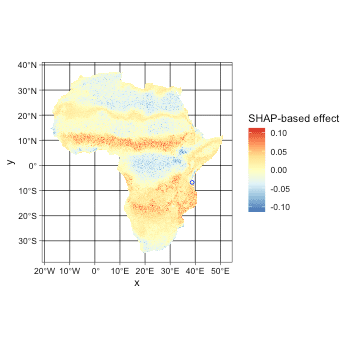Introduction of itsdm with a virtual species
Lei Song
2022-11-16
Source:vignettes/introduction_of_itsdm.Rmd
introduction_of_itsdm.RmdSet up
Install your missing packages
install.packages('rnaturalearth')
install.packages('here')
install.packages('virtualspecies')Prepare environmental variables
We could use packages like rnaturalearth to quickly get
the boundary of most countries and regions. You can also read your study
area boundary for sure. Providing your boundary to function
worldclim2 would allow you to download files from worldclim
version 2 clipping to your area.
library(stars, quietly = T)
library(rnaturalearth, quietly = T)
# Get Africa continent
af <- ne_countries(
continent = 'africa', returnclass = 'sf') %>%
filter(admin != 'Madagascar') # remove Madagascar
# Union countries to continent
af_bry <- st_buffer(af, 0.1) %>%
st_union() %>%
st_as_sf() %>%
rename(geometry = x) %>%
st_make_valid()
bios <- worldclim2(var = 'bio', bry = af_bry,
path = tempdir(),
nm_mark = 'africa')
# Plot BIO1 to check the variables
# plot(bios %>% slice('band', 1),
# main = st_get_dimension_values(bios, 'band')[1])In species modeling, people usually want to remove the strong
correlations between environmental variables. dim_reduce is
such a function you need. The function could either reduce the dimension
of your environmental variable stack itself or according to a bunch of
observations. It also allows you to set a desirable threshold. Note that
it only works on numeric variables. Because categorical variables have
less risk of having a high correlation with others, we usually prefer to
keep categorical variables.
library(stars, quietly = T)
# An example of reducing dimensions
## Here we didn't set samples, so use whole image
bios_reduce <- dim_reduce(
bios, threshold = 0.6,
preferred_vars = c('bio1', 'bio12', 'bio5'))
# Returned ReducedImageStack object
bios_reduce
#> Dimension reduction
#> Correlation threshold: 0.6
#> Original variables: bio1, bio2, bio3, bio4, bio5, bio6, bio7, bio8, bio9,
#> bio10, bio11, bio12, bio13, bio14, bio15, bio16, bio17, bio18, bio19
#> Variables after dimension reduction: bio1, bio12, bio9, bio14, bio15
#> ================================================================================
#> Reduced correlations:
#> bio1 bio12 bio9 bio14 bio15
#> bio1 1.00 -0.04 0.50 -0.07 0.44
#> bio12 -0.04 1.00 -0.03 0.56 -0.16
#> bio9 0.50 -0.03 1.00 0.01 -0.06
#> bio14 -0.07 0.56 0.01 1.00 -0.40
#> bio15 0.44 -0.16 -0.06 -0.40 1.00
# img_reduced of ReducedImageStack is the raster stack
bios_reduce$img_reduced
#> stars object with 3 dimensions and 1 attribute
#> attribute(s):
#> Min. 1st Qu. Median Mean 3rd Qu. Max. NA's
#> reduced_image 0 17.75392 25.91388 154.5419 83.09974 4347 447385
#> dimension(s):
#> from to offset delta refsys point values x/y
#> x 975 1388 -180 0.166667 WGS 84 FALSE NULL [x]
#> y 316 750 90 -0.166667 WGS 84 FALSE NULL [y]
#> band 1 5 NA NA NA NA bio1,...,bio15Creating the virtual species
Using virtual species is a crucial method in ecological studies.
First, let’s create a virtual species using the package
virtualspecies to know exactly what is happening.
library(here, quietly = T)
library(virtualspecies, quietly = T)
# Subset environmental variables to use
bios_sub <- bios %>% slice('band', c(1, 5, 12, 15))
bios_sub <- stack(as(split(bios_sub), 'Spatial'))
# Formatting of the response functions
set.seed(10)
my.parameters <- formatFunctions(
bio1 = c(fun = 'dnorm', mean = 25, sd = 5),
bio5 = c(fun = 'dnorm', mean = 35, sd = 5),
bio12 = c(fun = 'dnorm', mean = 1000, sd = 500),
bio15 = c(fun = 'dnorm', mean = 100, sd = 50))
# Generation of the virtual species
set.seed(10)
my.species <- generateSpFromFun(
raster.stack = bios_sub,
parameters = my.parameters,
plot = F)
# Conversion to presence-absence
set.seed(10)
my.species <- convertToPA(
my.species,
beta = 0.7,
plot = F)
# Check maps of this virtual species if you like
# plot(my.species)
# Check response curves
plotResponse(my.species)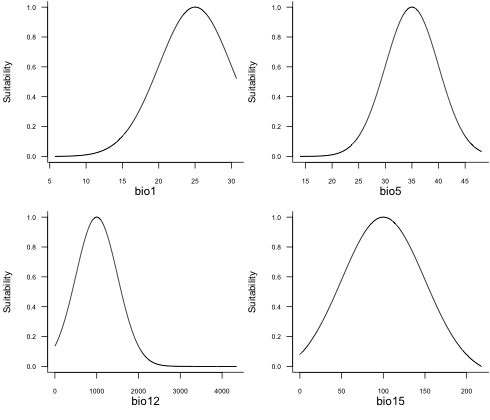
Generate pseudo samples for virtual species
# Sampling
set.seed(10)
po.points <- sampleOccurrences(
my.species,
n = 2000,
type = "presence only",
plot = FALSE)
po_df <- po.points$sample.points %>%
select(x, y) %>%
mutate(id = row_number())
head(po_df)
#> x y id
#> 1 -6.083333 11.083333 1
#> 2 -5.750000 10.250000 2
#> 3 38.750000 -6.750000 3
#> 4 39.250000 -10.416667 4
#> 5 26.583333 -8.583333 5
#> 6 0.250000 9.083333 6As we all know, there are commonly sampling bias and observation
errors. People use multiple methods to reduce these disturbances in
samples. For example, here, we use the function
suspicious_env_outliers to detect and/or remove possible
environmental outliers. This step could be used with other strategies to
do sample cleaning.
# Get environmental variable stack
variables <- bios %>% slice('band', c(1, 5, 12, 15))
# Check outliers
occ_outliers <- suspicious_env_outliers(
po_df,
variables = variables,
z_outlier = 5,
outliers_print = 4,
visualize = FALSE)
#> Reporting top 4 outliers [out of 6 found]
#>
#> row [463] - suspicious column: [bio5] - suspicious value: [32.78]
#> distribution: 95.714% >= 36.01 - [mean: 37.68] - [sd: 0.66] - [norm. obs: 67]
#> given:
#> [bio1] > [27.31] (value: 27.39)
#> [bio15] <= [102.79] (value: 102.48)
#> [bio12] <= [993.00] (value: 845.00)
#>
#>
#> row [1346] - suspicious column: [bio5] - suspicious value: [32.96]
#> distribution: 95.714% >= 36.01 - [mean: 37.68] - [sd: 0.66] - [norm. obs: 67]
#> given:
#> [bio1] > [27.31] (value: 27.41)
#> [bio15] <= [102.79] (value: 102.34)
#> [bio12] <= [993.00] (value: 855.00)
#>
#>
#> row [1728] - suspicious column: [bio5] - suspicious value: [33.42]
#> distribution: 95.714% >= 36.01 - [mean: 37.68] - [sd: 0.66] - [norm. obs: 67]
#> given:
#> [bio1] > [27.31] (value: 27.44)
#> [bio15] <= [102.79] (value: 66.08)
#> [bio12] <= [993.00] (value: 958.00)
#>
#>
#> row [821] - suspicious column: [bio5] - suspicious value: [31.90]
#> distribution: 98.333% >= 34.51 - [mean: 36.25] - [sd: 0.84] - [norm. obs: 59]
#> given:
#> [bio1] between (24.12, 25.70] (value: 24.70)
#> [bio15] > [113.08] (value: 128.18)
#> [bio12] <= [996.00] (value: 658.00)
# Check result
# You could also plot samples overlap with a raster
# plot(occ_outliers,
# overlay_raster = variables %>% slice('band', 6))
plot(occ_outliers)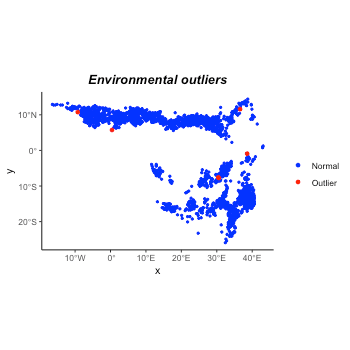
# Remove outliers if necessary
occ_outliers <- suspicious_env_outliers(
po_df, variables = variables,
rm_outliers = T,
z_outlier = 5,
outliers_print = 0L,
visualize = FALSE)
po_sf <- occ_outliers$pts_occ
# Make occurrences
set.seed(11)
occ_sf <- po_sf %>% sample_frac(0.7)
occ_test_sf <- po_sf %>% filter(! id %in% occ_sf$id)
occ_sf <- occ_sf %>% select(-id) %>%
mutate(observation = 1)
occ_test_sf <- occ_test_sf %>% select(-id) %>%
mutate(observation = 1)
# Have a look at the samples if you like
# ggplot() +
# geom_raster(data = as.data.frame(my.species$suitab.raster, xy = T),
# aes(x, y, fill = layer)) +
# scale_fill_viridis_c('Suitability', na.value = 'transparent') +
# geom_sf(data = occ_sf, aes(color = 'Train'), size = 0.8) +
# geom_sf(data = occ_test_sf, aes(color = 'Test'), size = 0.8) +
# scale_color_manual('', values = c('Train' = 'red', 'Test' = 'blue')) +
# theme_classic()
# Recheck the variable correlation
dim_reduce(variables, threshold = 1.0, samples = occ_sf)
#> Dimension reduction
#> Correlation threshold: 1
#> Original variables: bio1, bio5, bio12, bio15
#> Variables after dimension reduction: bio1, bio5, bio12, bio15
#> ================================================================================
#> Reduced correlations:
#> bio1 bio5 bio12 bio15
#> bio1 1.00 0.69 0.19 -0.22
#> bio5 0.69 1.00 -0.03 0.20
#> bio12 0.19 -0.03 1.00 -0.37
#> bio15 -0.22 0.20 -0.37 1.00Unfortunately, bio1 and bio5 have strong correlation with each other. This might affect the model explanation later.
Build a simple isolation_forest species distribution
model
Here we build a SDM using extended isolation forest (with
ndim = 2) and a sample rate of 0.8.
# Do modeling
it_sdm <- isotree_po(obs = occ_sf,
obs_ind_eval = occ_test_sf,
variables = variables,
sample_size = 0.8,
ndim = 2)Let’s compare the predicted suitability with real suitability.
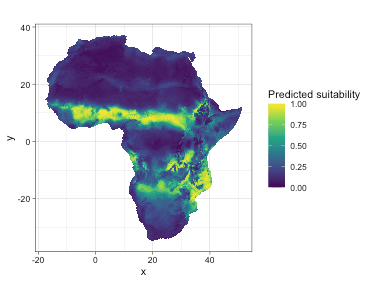
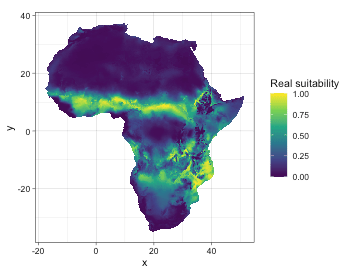
Let’s do model evaluation using multiple presence-only metrics. In
this package, we implement both presence-only and presence-background
evaluation metrics. The model calculated evaluation on both training and
test datasets. Here we just display evaluation on test dataset. You
could check it_sdm$eval_train the same way as
it_sdm$eval_test.
# Metrics based on test dataset
it_sdm$eval_test
#> ===================================
#> Presence-only evaluation:
#> CVI with 0.25 threshold: 0.640
#> CVI with 0.5 threshold: 0.809
#> CVI with 0.75 threshold: 0.704
#> CBI: 0.986
#> AUC (ratio) 0.942
#> ===================================
#> Presence-background evaluation:
#> Sensitivity: 0.972
#> Specificity: 0.856
#> TSS: 0.828
#> AUC: 0.946
#> Similarity indices:
#> Jaccard's similarity index: 0.849
#> Sørensen's similarity index: 0.919
#> Overprediction rate: 0.129
#> Underprediction rate: 0.028
plot(it_sdm$eval_test)
The result of isotree_po has options to generate
response curves and variable analysis together. The response curves
include marginal response curves, independent response curves, and
Shapley value-based dependence. The variable analysis consists of the
Jackknife of Pearson correlation with the result of the full model with
all variables and AUC_ratio and variable dependence with SHAP test.
# Plot response curves
## Marginal response curves of bio5 and bio6
plot(it_sdm$marginal_responses, target_var = c('bio1', 'bio5'))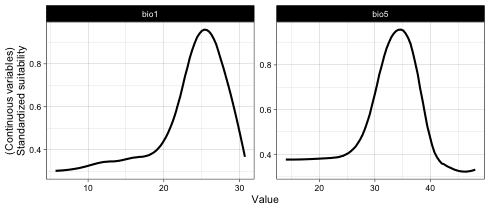
## Independent response curves of variable bio1 and bio12.
plot(it_sdm$independent_responses, target_var = c('bio1', 'bio12'))
## Variable dependence scatter points with fitted curves made by SHAP test
plot(it_sdm$shap_dependence, smooth_line = FALSE)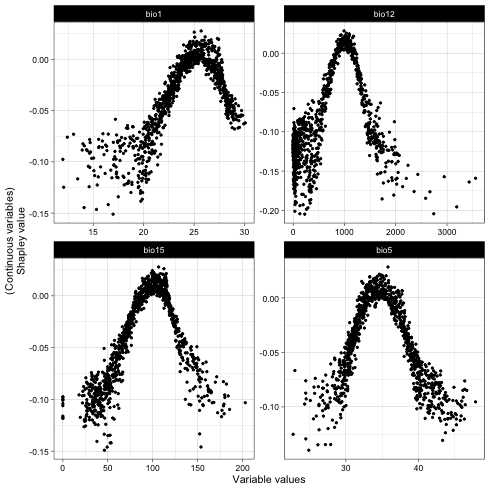
# Printing variable analysis could give you enough info of variable importance
it_sdm$variable_analysis
#> Relative variable importance
#> ===================================
#> Methods: Jackknife test and SHAP
#> Numer of variables: 4
#> ===================================
#> Jackknife test
#> Based on Pearson correlation (Max value is 1)
#> [Training dataset]:
#> bio12 With only: //////////////////////////////////////// 0.885
#> Without : ////////////////////////////////////////// 0.937
#> bio15 With only: //////////////////////////////// 0.71
#> Without : //////////////////////////////////////////// 0.974
#> bio5 With only: /////////////////////////////// 0.692
#> Without : //////////////////////////////////////////// 0.983
#> bio1 With only: //////////////////////// 0.543
#> Without : //////////////////////////////////////////// 0.983
#> [Test dataset]:
#> bio12 With only: /////////////////////////////////////// 0.878
#> Without : ////////////////////////////////////////// 0.934
#> bio5 With only: //////////////////////////////// 0.705
#> Without : //////////////////////////////////////////// 0.983
#> bio15 With only: //////////////////////////////// 0.703
#> Without : //////////////////////////////////////////// 0.976
#> bio1 With only: //////////////////////// 0.536
#> Without : //////////////////////////////////////////// 0.983
#> ======================================================================
#> Jackknife test
#> Based on AUC ratio (Max value of traing and test are 0.946 and 0.942)
#> [Training dataset]:
#> bio12 With only: //////////////////////////////////////// 0.898
#> Without : ///////////////////////////////////////// 0.921
#> bio5 With only: ///////////////////////////////////// 0.82
#> Without : ////////////////////////////////////////// 0.941
#> bio15 With only: //////////////////////////////////// 0.801
#> Without : ////////////////////////////////////////// 0.94
#> bio1 With only: ////////////////////////////////// 0.761
#> Without : ////////////////////////////////////////// 0.943
#> [Test dataset]:
#> bio12 With only: //////////////////////////////////////// 0.878
#> Without : ///////////////////////////////////////// 0.919
#> bio5 With only: //////////////////////////////////// 0.791
#> Without : ////////////////////////////////////////// 0.936
#> bio15 With only: /////////////////////////////////// 0.773
#> Without : ////////////////////////////////////////// 0.936
#> bio1 With only: ///////////////////////////////// 0.735
#> Without : ////////////////////////////////////////// 0.938
#> ======================================================================
#> SHAP (mean(|Shapley value|))
#> [Training dataset]:
#> bio12 : ############################################ 0.054
#> bio15 : ######################### 0.031
#> bio5 : ######################### 0.03
#> bio1 : ##################### 0.026
#> [Test dataset]:
#> bio12 : ############################################# 0.055
#> bio5 : ########################## 0.032
#> bio15 : ######################### 0.031
#> bio1 : ##################### 0.026
# We also could plot variable importance out
plot(it_sdm$variable_analysis)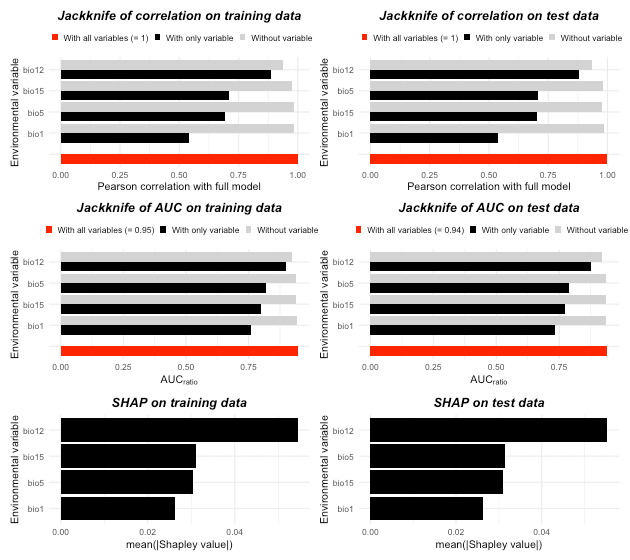
According to the analysis, all explanatory variables contribute significantly to the model. This is predictable because the virtual species is made by these four variables. bio12 is the most important variable.
Besides the regular response curves, itsdm also makes
spatially partial dependence maps. By default in
isotree_po, Shapley value-based spatial dependence maps are
not generated because of the computational efficiency. The user could
generate these maps by calling function spatial_response
later after getting the model done.
Note that a very large raster stack of environmental variables might cause memory failure or super slow computation when calculating Shapely value-based spatially dependence maps. So use it based on your own knowledge of your data. Shapley value-based dependence map will give you a bit more information of the value pushing the prediction higher or lower than average.
# Generate spatially partial dependence maps including Shapley value-based one
## Larger shap_nsim value could make smoother map but takes longer time as a
## trade-off
spatial_responses_all <- spatial_response(
model = it_sdm$model,
var_occ = it_sdm$vars_train,
variables = it_sdm$variables,
shap_nsim = 20)
# Plot spatial response maps
plot(spatial_responses_all, target_var = c('bio1', 'bio12'))
Marginal and independent effects only indicate the difference comparing the variable itself. And Shapley value based effect additionally show the relative contribution of one variable comparing to to other variables. For example, SHAP-based effect of bio1 shows that bio1 does not contribute much to the model over some areas even though it is an decisive variable.
The direct result of function isotree_po is
environmental suitability. We could use function
convert_to_pa to convert suitability to presence-absence
based on different methods: threshold, logistic, and linear conversion,
and/or a desirable species prevalence.
# An example of converting to presence-absence map
## Use logistic conversion with alpha = -0.05, beta = 0.5
## and not set species prevalence
pa_map <- convert_to_pa(it_sdm$prediction,
method = "logistic",
beta = 0.7, # the same with virtual species
alpha = -.05,
visualize = FALSE)
pa_map; plot(pa_map)
#> Logistic conversion
#> beta = 0.7
#> alpha = -0.05
#> species prevalence = 0.105503625307627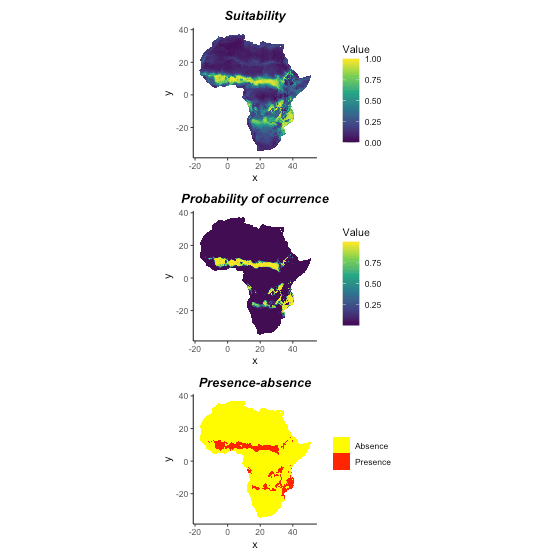
Analyze variable dependence
It is always helpful to understand the dependence among variables.
The result of function shap_dependence or
it_sdm$shap_dependence can be used to analyze variable
dependence with each other.
var_dependence <- shap_dependence(
it_sdm$model, it_sdm$vars_train,
variables = it_sdm$variables)
# Multiple ways to plot variable VariableDependence object
## Plot without smooth fit curve
plot(var_dependence,
target_var = c('bio1', 'bio12'),
related_var = 'bio5', smooth_line = TRUE)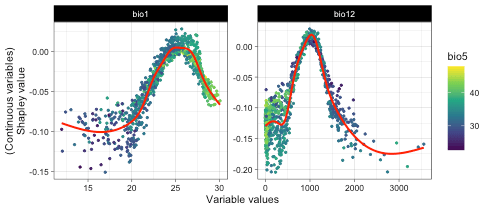
Above figure shows bio1 and bio5 have strong correlations.
Analyze variable contribution
Sometimes, we are interested in some observations, for instance, the
outliers. variable_contrib is such function that allows you
to analyze the contribution of each variable. It relies on Shapley
values.
## Analyze variable contribution for interested observations.
## For example, outliers.
var_contrib <- variable_contrib(
it_sdm$model,
it_sdm$vars_train,
it_sdm$vars_test %>% slice(1:6))
# Plot contribution separately for each observation
## By default, it only plot the most 5 important variables for each observation
## You could change `num_features` to show more variables
plot(var_contrib, plot_each_obs = T, num_features = 4)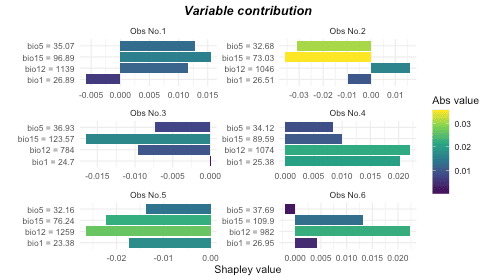
For example, No.2 observation is decided largely by bio15 and bio5 negatively. Let’s check it with spatial response map together.
ggplot() +
geom_stars(data = spatial_responses_all$spatial_shap_dependence$bio15) +
scale_fill_distiller('SHAP-based effect', palette = "RdYlBu",
na.value = "transparent") +
geom_sf(data = occ_test_sf %>% slice(2),
color = 'blue', pch = 1) +
theme_linedraw()